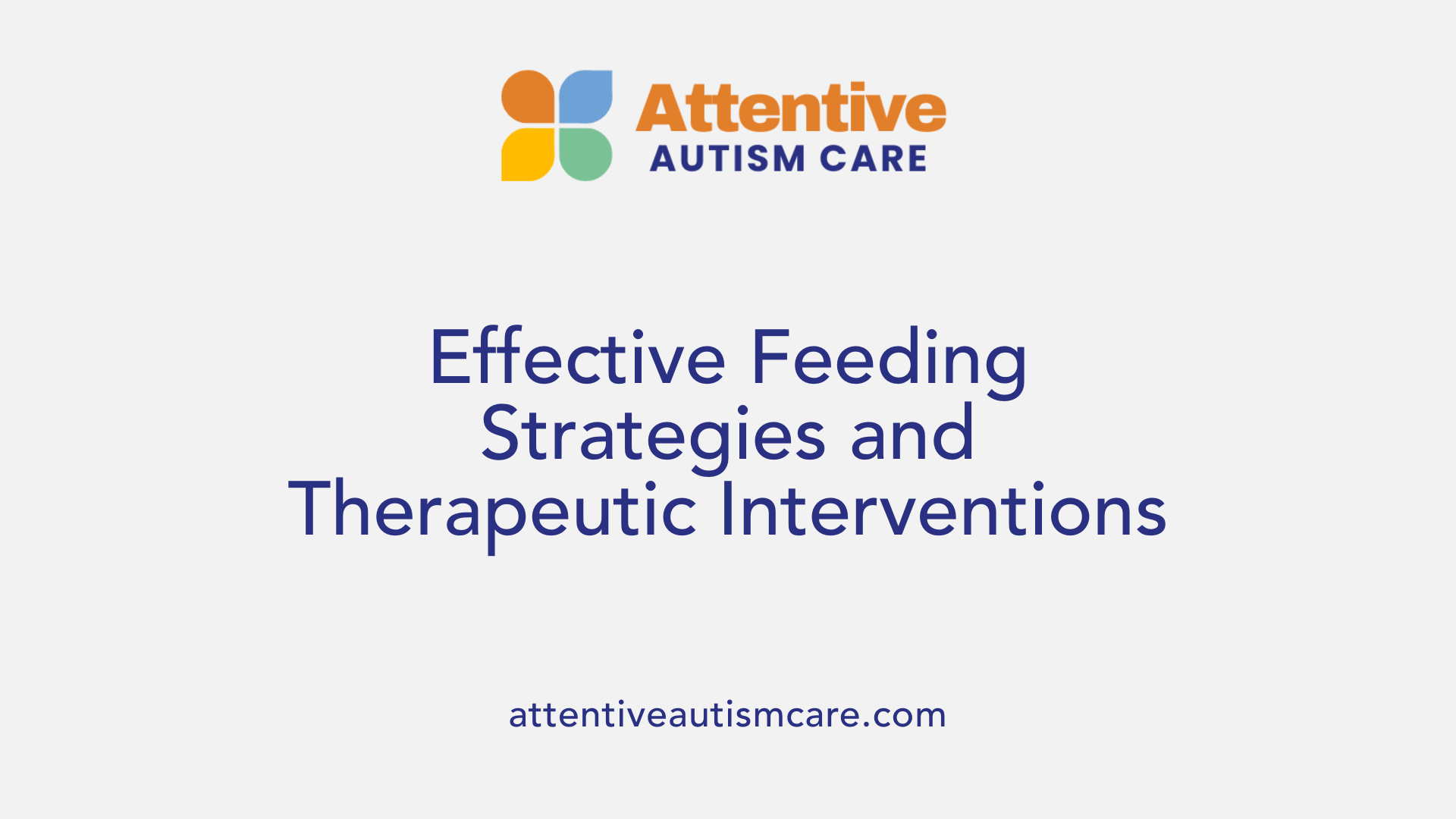Supporting Autistic Children in Overcoming Feeding Challenges
Innovative Strategies to Address Feeding Difficulties in Children with Autism Spectrum Disorder

Understanding Feeding Challenges in Autism
Feeding difficulties are common among children with Autism Spectrum Disorder (ASD), often stemming from sensory sensitivities, oral motor delays, and behavioral rigidity. These challenges can impact nutrition, growth, and overall health, requiring specialized interventions tailored to each child's unique needs. Addressing feeding issues early through comprehensive, individualized therapy can promote positive mealtime experiences and support healthy eating habits.
Personalized Nutrition Therapy for Autistic Children

How is the assessment of dietary habits and physical health conducted?
Nutrition therapy for children with autism starts with a comprehensive assessment of their dietary habits, food preferences, and physical health concerns, particularly gastrointestinal issues that are common in this population. Understanding these factors is essential to creating an effective and individualized nutrition plan.
What role do dietitians play in autism-specific nutrition plans?
Registered dietitians or nutritionists specializing in autism collaborate closely with families to develop personalized nutrition plans. These specialists ensure children receive adequate nutrient intake tailored to their unique needs and challenges. Their expertise allows them to consider factors that may influence eating behaviors and nutritional status.
How are sensory sensitivities and food preferences taken into account?
Sensory sensitivities—such as aversions to certain textures, tastes, or smells—are common in autistic children and can significantly affect their willingness to try or accept foods. Nutrition therapy is designed with these sensitivities in mind, adapting meal plans to accommodate them while gradually encouraging dietary variety. Food preferences are respected and used as a foundation to expand the child’s diet safely and comfortably, often involving gradual and supportive approaches to introduce new foods.
Each nutrition plan is highly individualized, ensuring that strategies align with the child's sensory profile, health needs, and family dynamics to promote healthier eating habits and overall well-being.
Feeding Therapy: Techniques and Therapeutic Approaches

Who Provides Feeding Therapy and What Methods Are Used?
Feeding therapy for children with autism is often delivered by occupational therapists, speech-language pathologists, or dietitians specialized in pediatric feeding disorders and autism. These professionals begin with a thorough assessment of the child's current feeding behaviors, sensory preferences, and oral motor skills to create individualized plans.
What Is Sensory Desensitization and Oral-Motor Training?
Sensory desensitization gradually exposes children to a variety of food textures, smells, and tastes. This approach helps reduce anxiety and fear around new foods by increasing tolerance through small, controlled experiences.
Oral-motor training focuses on strengthening the muscles essential for chewing and tongue coordination. Exercises from programs like the Beckman Oral Motor Approach improve muscle tone and the child's ability to handle diverse foods.
How Do Behavioral Interventions Promote Positive Mealtime Behaviors?
Behavioral strategies aim to establish calm, routine-based mealtimes and reduce anxiety. Techniques include positive reinforcement, reward systems, and minimizing distractions. Therapists often coach parents on creating supportive environments without applying pressure, which significantly contributes to success.
What Are Some Specific Techniques Used?
- Sequential Oral Sensory (SOS) Approach: Introduces new foods gradually in a playful, non-threatening way, starting from just touching or smelling the food to tasting.
- Food Chaining: Builds on familiar foods by slowly introducing similar tastes and textures.
- Sensory Integration Strategies: Use sensory play to help children become comfortable with different food-related sensations.
- Applied Behavior Analysis (ABA): Employs positive reinforcement to expand food acceptance and variety.
These approaches collectively reduce feeding difficulties by addressing sensory sensitivities, oral motor delays, and behavioral challenges common in children with autism.
Applied Behavior Analysis (ABA) Therapy in Feeding Interventions

What is Applied Behavior Analysis (ABA) therapy and how does it help individuals with autism?
Applied Behavior Analysis (ABA) therapy is a scientifically supported approach that uses behavioral principles to improve skills in individuals with autism. It targets various areas including social interaction, communication, learning, and daily living skills. ABA focuses heavily on positive reinforcement to encourage helpful behaviors and reduce problematic or disruptive ones. In feeding interventions, ABA helps children with autism develop new eating habits by systematically promoting acceptance of different foods and reducing mealtime anxiety.
Application of ABA in feeding behaviors
ABA therapy is applied to feeding by identifying the behaviors that hinder proper eating, such as food refusal or limited diet variety due to sensory sensitivities. Therapists use strategies like positive reinforcement to encourage trying new foods and increasing food variety. Techniques such as Discrete Trial Training (DTT) and natural environment teaching help children practice desired eating behaviors in controlled and natural settings. These approaches break down complex behaviors into manageable steps, making new eating experiences less overwhelming.
Main components and positive reinforcement strategies
Key components of ABA therapy include the ABC framework—Antecedents, Behaviors, and Consequences—to analyze events leading to feeding behaviors and adjust them accordingly. Reinforcement strategies often involve rewarding successful attempts at trying new foods or exhibiting calm mealtime behaviors. Prompting and shaping techniques gradually guide children toward more adaptive feeding habits. Behavioral interventions foster motivation and reduce resistance by incorporating rewards, praise, and structured routines.
Measurement of progress and individualized goals
Progress in ABA feeding therapy is closely tracked through continuous data collection, monitoring improvements in eating variety, oral-motor skills, and mealtime behaviors. Individualized goals are based on comprehensive assessments of each child's sensory preferences, motor abilities, and behavioral challenges. Therapists regularly review data to adjust strategies, ensuring that interventions are personalized and progress is meaningful. Success is defined by incremental gains unique to the child's developmental stage and needs.
Providers of ABA therapy for autism
ABA therapy for feeding challenges in autism is primarily delivered by Board Certified Behavior Analysts (BCBAs) who design and oversee treatment plans. Certified behavioral therapists implement these plans under supervision. Occasionally, occupational therapists or speech-language pathologists may integrate ABA techniques within feeding therapy. These professionals work collaboratively with families to tailor interventions that support positive and lasting changes in feeding behaviors.
The Positive Eating Program (PEP): A Structured Intervention

What are the PEP program phases and design?
The Positive Eating Program (PEP) is a carefully designed intervention targeting feeding difficulties in young children with Autism Spectrum Disorder (ASD). It breaks down feeding challenges into manageable phases: food awareness, nonfood sensory play, sensory food play, and structured food trials. Each phase aims to create a positive, predictable, and non-threatening environment for children to explore and accept new foods.
How does sensory play and gradual food exposure work in PEP?
Sensory play is a foundational element in PEP. Through nonfood and food items, children gradually desensitize to the sensory stimuli involved in eating, such as textures, smells, and tastes. This reduces overstimulation and food aversions. Following sensory play, the program uses hierarchical food trials where children engage in steps like touching, smelling, and biting new or non-preferred foods without pressure to ingest them. This gradual exposure helps ease anxiety and promotes acceptance.
How does PEP address behavioral challenges?
PEP emphasizes calm, predictable routines supported by visual aids to manage mealtime behaviors. Instead of punitive measures, the program uses natural consequences and consistent structure to reduce resistance and anxiety. This positive approach fosters trust and cooperation during feeding sessions, helping children develop healthier eating behaviors.
What role do parents and caregivers play in PEP?
Parental and caregiver involvement is crucial. Therapists coach families to implement calm, routine-based mealtimes at home, helping to generalize skills learned during therapy. This collaborative approach ensures that feeding improvements extend beyond the clinical setting into everyday environments.
How is data collection used for individualized intervention?
Ongoing data collection and progress monitoring allow therapists to tailor activities to each child's unique needs. Adjustments are made based on observed responses, ensuring the intervention remains effective and child-centered throughout its course.
Importance of Family Involvement and Environment in Feeding Success

Role of Parental Coaching by Therapists
Therapists working with children who have autism emphasize parental coaching as a cornerstone for feeding therapy success. They guide families in strategies to manage mealtimes effectively, ensuring that techniques learned during therapy sessions extend into daily life.
Creating Calm, Distraction-Free Mealtime Environments
A peaceful, distraction-free setting is crucial to reduce anxiety and help children focus on eating. Therapists advise families to minimize noise and visual triggers, fostering an environment conducive to positive eating experiences.
Importance of Routine and Avoiding Food Pressure
Establishing predictable mealtime routines helps children feel secure and supports behavior change. Parents are taught to avoid pressing children to eat, which can exacerbate resistance and anxiety around food.
Involving Children in Meal Preparation to Increase Food Acceptance
Engaging children in meal preparation boosts their interest in foods and gives them a sense of control. This involvement can encourage willingness to try new foods, making feeding therapy outcomes more sustainable.
Supporting Caregivers to Implement Strategies at Home
Successful feeding therapy relies on empowering caregivers with practical tools and ongoing support. Therapists collaborate closely with families to tailor approaches suitable for the home environment, promoting consistency and generalization of positive feeding behaviors.
Toward Positive, Individualized Feeding Outcomes for Children with Autism
Effective support for feeding challenges in autistic children relies on a comprehensive, multidisciplinary approach that integrates nutrition therapy, feeding and behavioral therapies such as ABA, and structured programs like the Positive Eating Program. Central to success is the personalization of interventions that respect sensory sensitivities, motor skills, and individual preferences, while fostering positive mealtime environments. Equally essential is the active involvement of parents and caregivers, who are coached to sustain therapeutic gains beyond clinical settings. This holistic approach not only improves nutrition and feeding behaviors but also supports children’s overall development and quality of life.
References
- Nutrition and Feeding Therapy for Children on the Autism ...
- ABA Feeding Therapy for Autistic Children
- Common Challenges and Solutions in Feeding Therapy for ...
- A Little PEP Goes a Long Way in the Treatment of Pediatric ...
- ABA Therapy Examples, Definition & Techniques
- Applied Behavior Analysis (ABA)
- Applied Behavior Analysis (ABA)
- Applied Behavior Analysis (ABA)



































































































